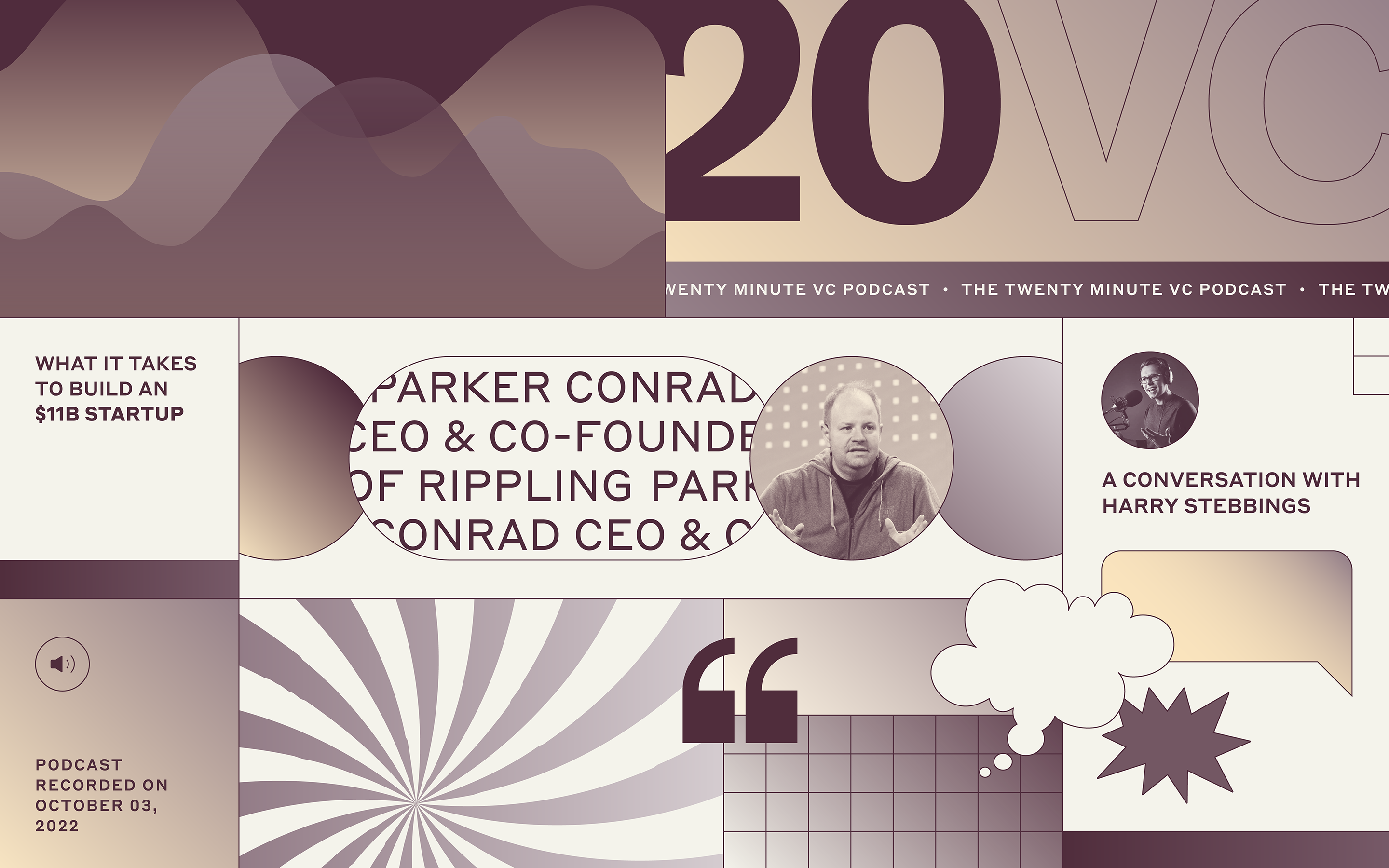5 reasons startup leaders should go big from the start: lessons from Rippling CEO Parker Conrad

People get a lot of things wrong about startups—even the people who lead them. There’s a lot of advice out there about how to run a startup and much of it is good. But a lot of the conventional ideas about what a startup should do and how it should operate are approaching their expiration date. While there’s no universal formula for building a sustainable, scalable business that can grow and adapt as the market shifts, there are ways to approach your startup from the very beginning that can dramatically change your reach and impact.
Rippling CEO Parker Conrad understands the value of breaking from tradition, and he’s witnessed the benefits firsthand. By applying different principles to Rippling from Day One, Parker earned a perspective that he now shares with other startup leaders. He shared these ideas at the Startup Grind Global Conference 2021 and we’re expanding his advice here to give you even more insight into building a successful startup.
Key Idea #1: A narrow focus leads to missed opportunities and steeper competition
For years, startup leaders have been told to create a super narrow focus for their products and services, and even warned that broadening the scope would be dangerous. Parker wholeheartedly disagrees with this advice. Speaking primarily of SaaS startups, Parker says having a super narrow focus “has held back the industry and has held back a lot of really important companies that could have been created but have not been.”
By definition, restricting your startup to a narrow focus limits the types of problems that you work on. “When you think about the problems your clients have, they often span a lot of different business systems or point solutions,” says Parker. “In fact, I think some of the biggest problems and therefore the problems that potentially could give rise to the most valuable companies tend to be things that span a lot of different point solution products within a business. And therefore, only building one point solution product can't really address them.”
Once upon a time, a small company could dominate a super niche space, Parker acknowledges, but now “there are actually a lot of different companies operating in all of these different narrow point solution verticals. So there is actually now a lot more opportunity if you can go bigger and combine a bunch of these different point solutions into one product.”
There’s also a bit of a myth around the notion that you should start small and expand later on. Historically, that doesn’t happen often. “Companies that focus early on tend to continue to focus,” Parker says.

If you take on a series of different but closely related products and do them all at once, there are these islands of undiscovered product market fit that are just beyond the horizon line—that no one has sailed out to because of all of this advice that you should narrow your ambition.
Parker Conrad
CEO, Rippling
Key Idea #2: The “compound startup” can be more effective
The remedy to the pitfalls of a narrow focus is a compound startup.
“A compound startup is a startup that instead of just doing one very narrow thing, tries to build a whole set of different point solution systems in one coherent product and tackle several different related point solutions at once to solve a much larger problem for businesses,” Parker says. “Why would you do this? Because there are a lot of reasons why it's hard. The first thing is this idea that these compound startup opportunities are relatively unexplored, because everyone has been focusing for so long. If you take on a series of different but closely related products and do them all at once, there are these islands of undiscovered product market fit that are just beyond the horizon line—that no one has sailed out to because of all of this advice that you should narrow your ambition and your focus to just one very specific thing, which often isn't enough to get you from point A to point B.”
When you break out of the narrow focus, you can really work on solving your customers’ problems. “The companies that tend to be bigger and more ambitious are solving the whole problem as opposed to just building a tool,” says Parker.
Key Idea #3: Integration is the product
When your approach to your products and services is very narrow, you miss out on opportunities left and right. Parker urges startup leaders to think about integration first and foremost.
“The types and the depth of integration you can have when you're building a set of related products together in-house is so much more powerful than what you can do through a set of APIs with other vendors,” says Parker. “There are a set of often shared components. You can identify certain bits of functionality or certain parts of the product that end up being reused across a number of different products that you're building, and you can build those once and gain some advantages on R&D efficiency. But more importantly, you can afford to go much deeper and invest much more deeply on those critical pieces that are shared across these different products.”
Doubling down on these shared components benefits your process, helps you build better solutions, and also vastly improves the user experience. When you have multiple solutions within one UX, customers spend less time learning and more time doing.
“When they learn how to use your product, they also learn how to use four different products,” says Parker. “They don't have to do things in four different ways across four completely separate products.”
This isn’t just about adding integrations across your products, though. To reap the full benefits of this approach, Parker says, “the product is the integration.” This allows startup leaders to create more robust solutions and continue growing as you work on solving new or different problems.
While this idea isn’t the standard startup approach, the concept isn’t brand new. There are tons of proven examples, many of which we touch on a daily basis. Microsoft is a key example, with the integration of Active Directory across countless product lines—with the advantage of having the same contract, same deployment, and consistent user experience across the range. Rippling was built in a similar way, to address disparate employee data records and give customers a seamless experience.

The companies that tend to be bigger and more ambitious are solving the whole problem as opposed to just building a tool.
Key Idea #4: Maximize the price of bundled solutions
Parker recognizes a key competitive advantage in the compound startup approach: bundled pricing. When your startup creates multiple integrated solutions rather than a single tool, you can undercut competitors on the price of each product and effectively compete with vendors that only focus on one thing.
“There's this incredible contracting and pricing advantage where the bundled contract or system allows you to optimize your price for the value of the bundle rather than the value of any specific point solution,” says Parker. “The focused startup has to maximize their revenue from one single SKU. But a compound startup can maximize revenue across a bundle and optimize for the bundled price, and therefore deliver cost savings to clients on the individual products and focus startups in aggregate. If a client has a lot of different point solutions, eventually it becomes a real headache to manage. Compound startups reduce complexity by consolidating a lot of these systems into one.”
Key Idea #5: The structure of your startup matters—a lot
The structure of a compound startup might look a little different from a traditional startup, too, and that’s not incidental. Parker insists startup leaders must organize for parallel execution, using product owners or business units to distribute areas of responsibility.
“We (Rippling) have an engine of about half the company in engineering,” says Parker. “First of all, it's a much higher percentage than most other SaaS businesses. But it's not a monolithic team. There's really this loose federation of much more individually focused teams—there's a team that builds payroll, there's a team that builds device management, there's a team that builds insurance and benefits administration. Each of those teams individually have a tremendous amount of focus. It also means you need to hire people differently, so you need people who can run those teams like business units that are both engineering teams and also cross-functional. They include customer support, product management, design, and so on.”

The types and the depth of integration you can have when you're building a set of related products together in-house is so much more powerful than what you can do through a set of APIs with other vendors.
Building a compound startup is hard work but worth it
Parker’s advice for startup leaders represents a shift away from old habits. His experience building Rippling, which offers a wide variety of solutions on a single platform, convinced him of the value of the compound startup approach, and as we look to the future, we believe the demand for integrated solutions will increase. Companies that commit to a narrow focus now will struggle to adapt or, more likely, get left behind as new startups embrace the compound approach from the beginning.







